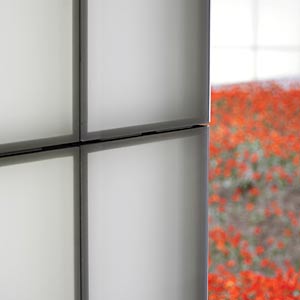Acrylic Foam Structural Glazing Tape: A New Bonding Alternative
First U.S. Application of Acrylic Foam Tape for Structural Glazing
 Typical assembly configuration of structural glazing using acrylic foam structural glazing tape. Drawing supplied by 3M |
|
Appearance was the driving force behind the decision to use acrylic foam tape for the first time in the U.S. for structural glazing. The Liberty Memorial, in Kansas City, MO., is a National Historic Landmark dedicated in 1921 to commemorate World War One. The new museum, designed by ASAI Architecture, (since merged with PGAV Architects) features an underground addition with the original memorial tower at its center.
The core of the underground museum is enclosed by a large glass drum wall, 300-feet in diameter, two stories high and made up of approximately 4-feet wide, 6-feet high, pieces of glass. Steve Abend, FAIA, principal and lead designer, explains that the entire drum is designed as a luminous translucent time capsule that rises out of the earth and appears to be going through the roof. Clad with laminated glass with a white inner layer, the drum glows and provides the only light for the entire lobby of the museum.
The glass is structurally glazed to a mullion system located out-of-sight behind the glass in an interstitial space for lighting and maintenance. Since he required the mullion system to be as invisible as possible, Abend wanted the joints to be white like the glass so it would read as a ghost. Since there was no white silicone sealant with the needed structural properties on the market, he selected white acrylic foam tape. In addition to being the correct matching color, the tape had the additional advantage of delivering very crisp lines. "The edges of the tape were all pre-cut so it was much more precise than we could have gotten from a sealant," reports Abend. By eliminating the sealant, which normally would have occurred between the glass pieces, he adds, it is now possible to see the crystalline edges of the glass.
|
||||
Typical Acrylic Foam Structural Glazing Tape Product Information. Note: This technical information and data should be considered representative or typical only and should not be used for specification purposes. |
"It saved us some money by eliminating the sealant," Abend says. "And we're told by the contractor that the erection−installation time was reduced. So it benefited the project with some modest cost savings. It benefited the contractor with some cost savings. And it gave us the look we needed for the project." As required with every acrylic foam tape structural glazing project., the tape manufacturer provided much technical support throughout the project-one example: sending a technical representative to the contractor's shop to train and demonstrate proper installation techniques that helped with quality control and reduced installation time.











